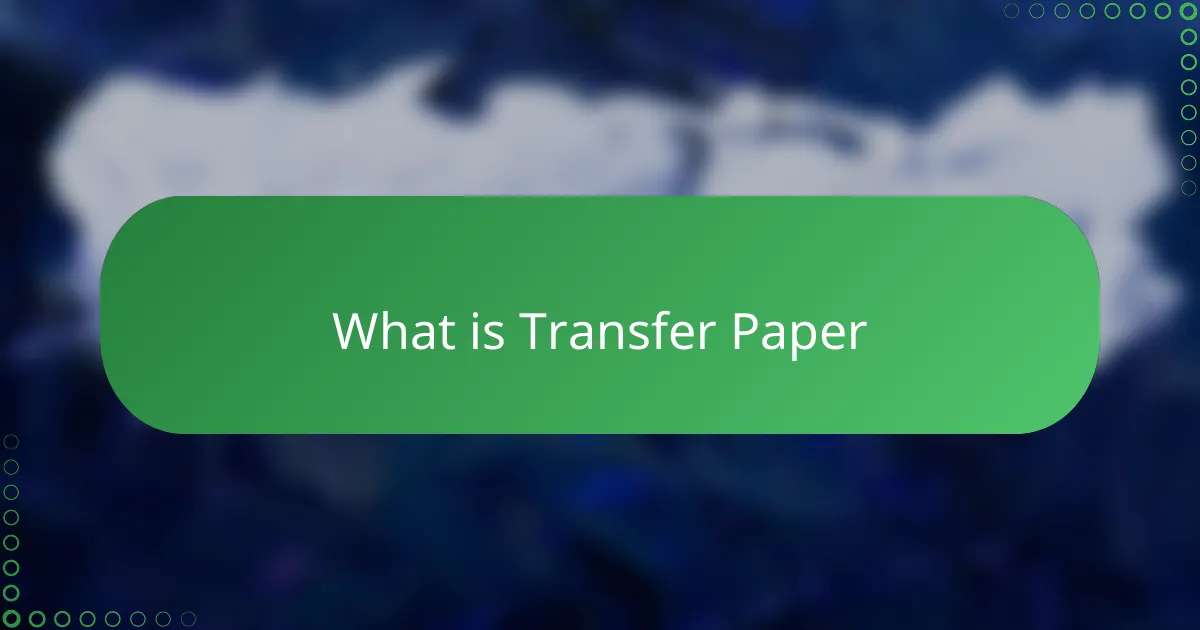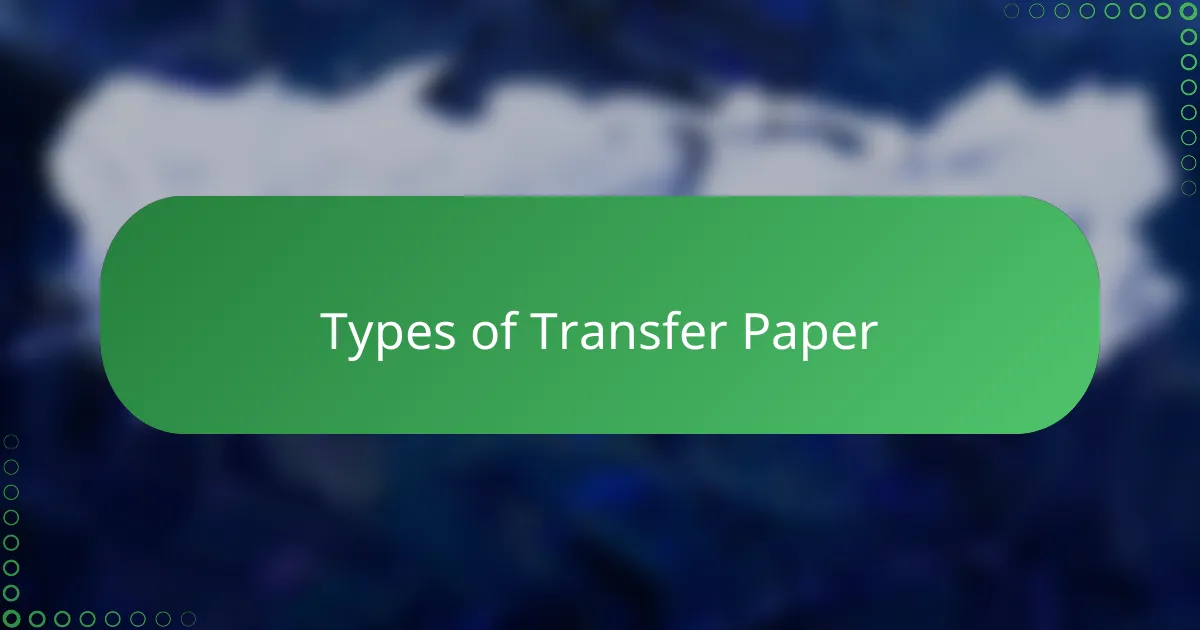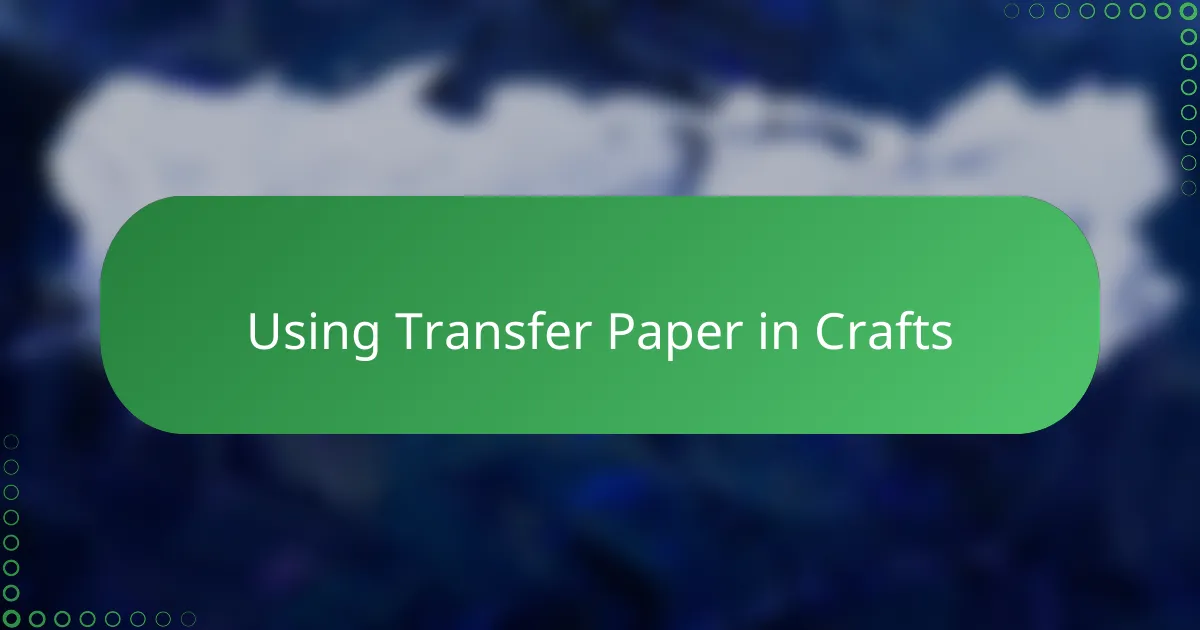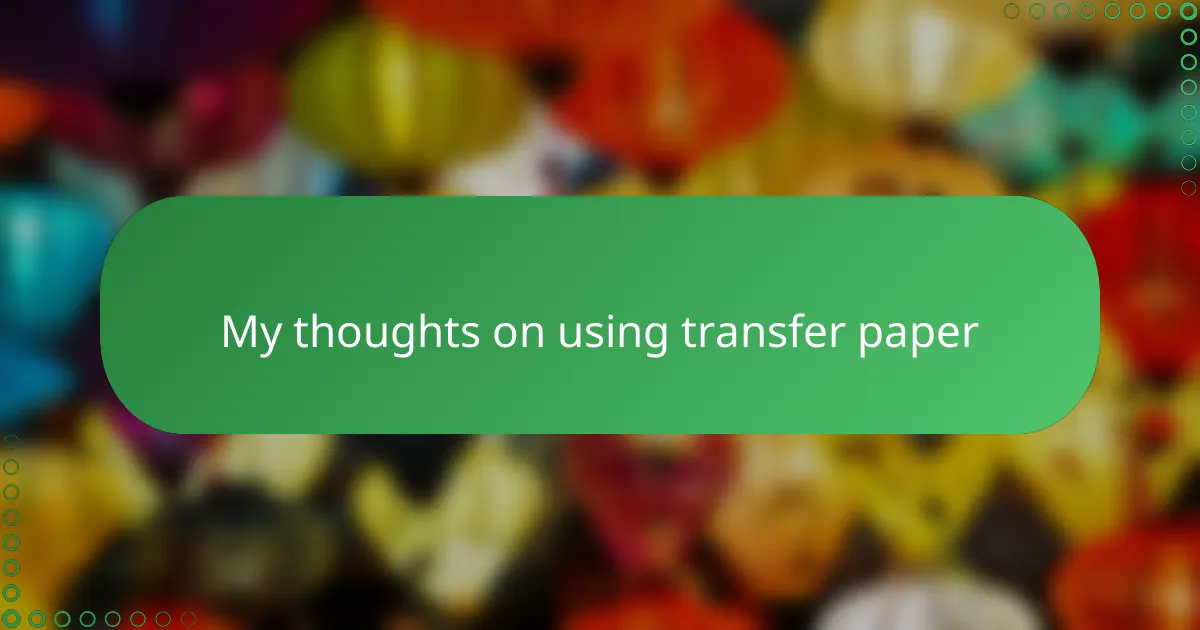Key takeaways
- Transfer paper is essential for accurately transferring designs onto various surfaces, enhancing the precision of handmade crafts.
- Different types of transfer paper (carbon, graphite, heat transfer) each have unique properties that cater to specific projects.
- Achieving optimal results with transfer paper requires the right pressure, a clean workspace, and patience during the process.
- Common challenges include smudging, uneven surfaces, and alignment issues, which can be overcome with practice and careful technique adjustment.

What is Transfer Paper
Transfer paper is a special kind of paper used to transfer images or designs onto another surface. From my experience, it feels a bit magical the first time you see a clear, detailed design move from the paper to your craft without much effort. Have you ever wondered how intricate patterns get perfectly replicated by hand? Transfer paper is often the secret behind that precision.

Types of Transfer Paper
When I first started exploring transfer papers, I was surprised by how many types there are. Carbon transfer paper, for example, is something I often reach for when working with fabric or darker surfaces. Its thin, waxy texture makes it easy to get crisp lines, though sometimes the marks can smudge if you’re not careful.
Another type I’ve grown fond of is graphite transfer paper, which feels smoother and leaves a softer line compared to carbon paper. I remember using it on delicate handmade cards where I didn’t want the marks to overpower my designs. Its subtlety really helps when you want to erase or paint over your transfers without any hassle.
Have you ever tried heat transfer paper? That was a game-changer for me when adding custom designs to wood or canvas. With just a quick run under a heat source, the image fuses beautifully onto the surface. Each kind of transfer paper has its quirks, but discovering which one suits your project best is part of the fun in handmade crafts.

Using Transfer Paper in Crafts
Using transfer paper in crafts has been a real eye-opener for me. I remember struggling with freehand drawing for hours, only to see uneven lines. The moment I tried transfer paper, it felt like a light switch flipped—suddenly, my designs looked neat and professional with far less effort. Have you ever felt that relief when a tricky step suddenly becomes simple?
One thing I’ve noticed is that the choice of surface really matters. When I used transfer paper on textured handmade paper, the lines didn’t always transfer perfectly, which taught me to adjust my pressure and technique. It’s a little trial and error, but each “oops” helped me understand how to get the best results on different materials.
What I truly appreciate is how transfer paper gives me confidence to experiment. Knowing I can replicate my favorite sketches onto various surfaces without fear of messing up encourages me to try bolder, more complex designs. It’s like having a creative safety net, allowing my ideas to flow more freely.

Tips for Best Results
Achieving crisp, clear lines with transfer paper often comes down to the right amount of pressure. I’ve learned the hard way that pressing too lightly results in faint, incomplete designs, while pressing too hard can tear delicate handmade paper. Finding that sweet spot feels like a small victory every time—have you found your ideal touch yet?
Another tip I can’t stress enough is keeping your transfer paper and work surface clean. Early on, I noticed smudges and unexpected marks ruining my final piece, and it took me a few frustrating tries to realize that paper fibers and dust make a big difference. Now, I always wipe down my surface and handle the paper gently, and the results speak for themselves.
Finally, don’t rush the process. I admit I used to move quickly, eager to see the finished design, but patience truly pays off. Taking a moment to align your transfer paper carefully and letting it rest for a few seconds before lifting ensures every detail sticks perfectly. Trust me, this small pause has saved me from many headaches.

Common Challenges
One challenge I’ve often faced is dealing with smudging, especially when using carbon transfer paper. Have you ever gotten so close to finishing that perfect design, only to accidentally smear part of it? It’s frustrating, but I’ve found that setting the paper aside briefly to let the transfer settle can really help.
Another tricky part is working on uneven surfaces. In my early projects, I remember how the lines would break or come out faint when the paper beneath had texture or bumps. Adjusting the pressure took some practice—too much, and the handmade paper tore; too little, and the design barely showed. It taught me patience and a gentler touch, which actually improved my overall technique.
Sometimes, I’ve struggled with aligning the transfer paper correctly, leading to off-center or crooked images. Have you ever lifted the paper only to realize your whole design shifted? That moment of disappointment stuck with me for a while. Now, I take extra time to carefully position everything before pressing down, and it makes the process so much less stressful.

Personal Experiences with Transfer Paper
There was something unexpectedly satisfying the first time I peeled back the transfer paper and saw my design perfectly imprinted onto the handmade paper beneath. Have you ever had that little rush of pride when a method just clicks? For me, transfer paper transformed what used to be a nerve-wracking tracing step into a moment of creative joy.
I remember one project where I tried to transfer an intricate floral pattern onto a rough-textured sheet, and the lines came out patchy in places. At first, I felt frustrated, but that experience taught me to be patient and fine-tune my pressure carefully. That gentle adjustment made a huge difference, and I realized how much transfer paper invites you to slow down and really connect with your craft.
Sometimes, I’ve found myself hesitating before lifting the paper, worried that a misstep would ruin hours of work. But more often than not, the transfer comes through beautifully, almost like the paper is reading my intentions. It makes me wonder—how many of these little tools have we overlooked that can quietly boost our confidence and creative flow?
